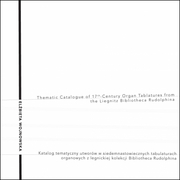"Thematic catalogue of 17th-century organ tablatures from the Liegnitz Bibliotheca Rudolphina" by Elżbieta Wojnowska
Thursday, September 1, 2016

A thematic catalog by Elżbieta Wojnowska (1949-2012) has just been published by the National Library of Poland:
Elżbieta Wojnowska, Thematic Catalogue of 17th-Century Organ Tablatures from the Liegnitz Bibliotheca Rudolphina, ed. Tomasz Jeż. Warsaw: Biblioteka Narodowa, 2016.
The catalog documents four manuscript organ tablatures that were originally held by the Bibliotheca Rudolphina in Liegnitz (now Legnica), Poland with the former shelfmarks Libr.Mus. 98-101. The second tablature in this group is considered lost, but its contents could be reconstructed for this publication on the basis of a nineteenth-century inventory by Ernst Pfudel. The first and third tablatures are housed today at the National Library of Poland in Warsaw (PL-Wn, shelfmarks Mus.327 Cim. and Mus.326 Cim respectively), and the fourth is still in Legnica at the Biblioteka Towarzystwa Przyjaciół Nauk (PL-LEtpn, shelfmark S/5).
For many years of her life, our colleague Elżbieta Wojnowska, who unfortunately left us much too early, studied the holdings of the former Bibliotheca Rudolphina in Lower Silesia. The Bibliotheca Rudolphina is currently the object of study in a RISM Poland project to document the holdings of this library, which are today dispersed throughout Poland. One part of this collection is made up of the four organ tablatures, whose contents Wojnowska wanted to make accessible to everyone in an easy-to-understand catalog.
Organ tablatures use a special notation. The Legnica organ tablatures are written using the “new” German organ tablature system, which utilizes an especially space-saving and abbreviated notational method. The openings of each work in the surviving tablatures were transcribed for the catalog using five-line staves with treble and bass clefs. The music repertoire is characterized by mostly polyphonic sacred vocal music of the sixteenth and seventeenth centuries in Latin and, much more rarely, German. Secular vocal music in Italian forms a very small portion of the repertoire. The tablatures here are not underlaid with text, but the text that was to be sung is indicated by a text incipit at the beginning of the piece. Often, the pieces are well-known repertoire from the time that were often published elsewhere in printed scores and partbooks or copied by hand, as the frequent concordances in the catalog show. Many of the works are documented as printed editions in the RISM A/I and B volumes.
Among the Warsaw tablatures there are only a few anonymous works because most of the pieces have the name of the composer in the original titles. In contrast, as much as a third of the pieces in the Legnica volume are anonymous. Anonymous works in the missing tablature amount to about one sixth. As a whole, therefore, the tablatures offer a broad swath of repertoire by many German and Italian composers. Works by Dragoni, Marenzio, and Palestrina as well as Gumpelzhaimer, Hassler, and Vulpius can be found often. Even works by Bonhomme are found relatively often. The number of composers is around 150 total.
The three extant tablatures are completely in RISM:
- Biblioteka Narodowa (PL-Wn), Mus.327 Cim. (olim Libr.Mus. 98) RISM ID no.: 300505000
- Biblioteka Narodowa (PL-Wn), Mus.326 Cim. (olim Libr.Mus. 100) RISM ID no.: 300042629
- Biblioteka Towarzystwa Przyjaciół Nauk (PL-LEtpn), S/5 (olim Libr.Mus.101). RISM ID no.: 301012250
In the RISM catalog, references to Wojnowska’s catalog are included using the abbreviation WojnowskaC 2016.
Share Tweet EmailCatégorie: Nouveautés

